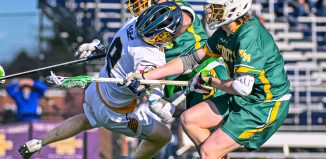CSHL’s Ela Elyada finds new pancreatic cancer associated cell
By Daniel Dunaief
They have the ability to call the body’s armed forces. They may interact with the immunological foot soldiers and, then, somehow, inactivate them, allowing the destructive cancer they may aid and abet to continue causing havoc.
This is one hypothesis about how a newly discovered class of fibroblasts may play a role in the progression of pancreatic cancer.
Ela Elyada, a postdoctoral fellow in David Tuveson’s lab at Cold Spring Harbor Lab, partnered up with Associate Professor Paul Robson at the Jackson Laboratory in Farmington, Connecticut, to find a new class of fibroblast in pancreatic cancer.
This cell, which they called antigen-presenting cancer-associated fibroblasts (or apCAFs) had the same kind of genes that are usually found in immune cells. Cells with these genes have signals on their surface that present antigens, or foreign parts of viruses and bacteria to helper T-cells. Elyada and Robson showed that the apCAFs can use their immune cell genes to present peptides to helper T-cells.
With the apCAFs, the researchers hypothesize that something about the immunological process goes awry, as the T-cells show up but don’t engage.
Elyada and Robson suspect that the activation process may be incomplete, which prevents the body’s own defense system from recognizing and attacking the unwelcome cancer cells.
While she was excited about the potential of finding a different type of cell, Elyada needed to convince herself, and the rest of the scientific community, that what she’d found was truly original, as opposed to a scientific mirage.
“We spent hours and hours trying to understand what is different in this type of cell,” Elyada said. “Like everything new you find, as a scientist, you really question yourself, ‘Is it real? Is it an artifact of the single cell?’ It was really important for me to do everything I could from every angle to make sure they were not macrophages that looked like fibroblasts or cancer cells that looked like fibroblasts.”
After considerable effort, Elyada was sure without a doubt that the group had found fibroblasts and that these specific cells, which typically are involved in connective tissue but which pancreatic cancer uses to form a shell around it, contained these immunological genes.
She sees these cells in different experiments from other people inside and outside the lab, which further supports her work and found the apCAFs in mice and human pancreatic ductal adenocarcinoma, which is the fourth leading cause of cancer-related deaths in the world.
The fibroblasts, which are not cancerous, play an unclear role in pancreatic cancer.
Elyada explained that single-cell sequencing enables scientists to look at individual cells, instead of at a whole population of cells. Scientists “have started to utilize this method to look at differences between cells we thought were the same,” she said. “It’s useful for looking at the fibroblast population. Scientists have appreciated that there’s probably a lot of heterogeneity,” but they hadn’t been able to describe or define it as well without this technique.
The results of this research, which was a collaboration between Elyada, Robson and others, were recently published in the journal Cancer Discovery. Robson said it was a “great example of how [single-cell RNA sequencing] can be very useful in revealing new biology, in this case, a new subtype of cancer-associated fibroblast.”
Earlier work in the labs of Robson and Tuveson, among others, have shown heterogeneity within cancer-associated fibroblast populations. These often carry a worse prognosis.
“We are very interested in continuing to explore this heterogeneity across tumor types and expect we will continue to find new subtypes and, although we have yet to confirm, would expect to see other solid tumor types to contain apCAFs,” Robson said.
“We still need to work hard to reveal their function in the full animal, but if they turn out to be tricking the immune cells, they could be a target for different immune-related inhibition methods,” explained Elyada.
The newly described fibroblast cells may be sending a signal to the T-cells and then either trapping or deactivating them. Elyada and Robson both said these results, which they developed after working together since 2016, have led to numerous other questions. They want to know how they work, what the mechanisms are that allow their formation, what signals they trigger in T-cells and many other questions.
Elyada is working with Pasquale Laise in Andrea Califano’s lab at Columbia University to gather additional information that uses this single-cell sequencing data.
Laise has “a unique way of analyzing [the information] to look at how the sequencing can predict if proteins are active or not active in a cell,” she said. Laise is able to predict the activity of transcription factors according to the expression level of their known target.
Elyada may be able to use this information to understand the source cell from which the fibroblasts are coming.
Originally from Israel, Elyada has been working as a postdoctoral researcher in Tuveson’s lab for about six years. She lives in Huntington Village with her husband Gal Nechooshtan, a postdoctoral researcher at Cold Spring Harbor Laboratory’s Woodbury complex. The couple has two daughters, Maayan, who is 10, and Yael, who is 8.
Elyada hopes to return to Israel next year, where she’d like to secure a job as a professor and build on the work she’s done at CSHL.“I definitely want to keep working on this. This would hopefully be a successful project in my future lab.”







